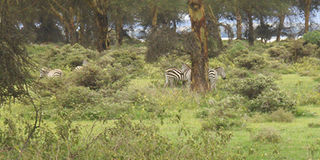Stunning glimpses of paradise

Zebras grazing on the lush shores of Lake Naivasha
What you need to know:
- Lake Naivasha is home to hundreds of species of birds, but, unfortunately, humans have destroyed much of this Eden.
It’s a picture-perfect snapshot of Lake Naivasha lying in a basin between Mount Longonot and Mount Eburru, the two dormant volcanoes on the valley’s floor, and bordered by the Mau hills.
We’re at Hippo Point. It’s lush and green, the road leading to the lake straddled with the tall yellow-barked acacias, once given the mistaken identity of yellow fever trees, which were dreaded by early explorers.
A herd of Rothschild giraffes forage on the trees, with herds of buffaloes, zebras and impalas whiling away the day. Life’s bliss with none of the big predators around.
A booted eagle soars above and has everyone excited because it breeds in southern Europe, North Africa and Asia, and migrates during winter to sub-Saharan Africa and South Asia.
A band of three African hoopoes fly into the acacia, calling “hoo poe”. They are just beautiful in orange plumage and a tiara on the head.
Dazzling variety
Walking to the waterfront, an enormous bird of prey stops everyone in their tracks. Peering with binoculars through the tall trees, it takes some time before we identify it as a tawny eagle. That done, we continue to the lake that is filled with a dazzling assortment of water birds.
Sometime between August and September 1883, Joseph Thomson, the formidable explorer, was the first white man to scale Longonot from where he had an uninterrupted view of Lake Naivasha and the dark range of the Mau rising to a height of more than 9,000 feet.
‘Enaiposha’, as the Maasai called it for its rough waters, was a “moving mass of ducks, ibises, pelicans and other aquatic birds”, described Thomson. Hippos were numerous. Hundreds of yellow-billed storks stride this way and that.
I’ve never seen such numbers in one place. They look focused – sifting the shallow shores for tasty morsels of fish and frogs.
Pink-back pelicans swim in flotillas to herd the fish together and then scoop them in their mighty beaks. The larger great white pelicans keep their distance, as do the pretty pink flamingoes of the lesser type. The world looks problem-free.
Even the mighty African fish eagle perches on a tree a few metres from us as we enjoy the potluck picnic.
Amazing views
Wire-tailed swallows skim fast with a young one in tow. Like the yellow-billed storks and the spoon-billed storks and the pelicans, there are hundreds. Then we hear that unmistakable excited voice of Fleur Ng’weno, one of the world’s most respected birders. When she sounds like that, it means there’s a great sighting.
This time, it’s a flock of Eurasian bee-eaters flying against a blue sky dotted with white buds of clouds. These small jewelled birds, turquoise below and golden brown above, could fit in the palm of a hand. They are also here from eastern Europe and western Asia.
Large feathers, possibly of a pelican, lie scattered on the green ground. Kevin Gichuki, one of the best birders, gives a little insight into bird morphology.
You can tell which side of the bird the wing feather is by checking the shaft. If it slopes to the right, it’s from the right side. It’s not something you think about every day. The hippos snort and waterbucks pose by the lake, which reflects the massifs. The fishermen with their nets and basket traps wade in in the late afternoon.
Flower farms
The deceptive purple flowers look pretty and an African lily trotter daintily walks on the floating leaves. Red flowers mingle with the purple, another invasive known as Azolla and the green salad-like salvinia. Lake Naivasha is an amazing lake. Until the huge tracts of flower farms swept away the beautiful reeds, it was pristine.
Now only a few spots like Hippo Point remain for the water birds to frequent. The picture-perfect rosy view of the lake from Hippo Point is deceptive for there are concerns about the dwindling numbers of the raptors like the African fish eagle and others at the top of the food chain.
When their numbers decline, it’s a worrying sign that all other species are reducing. Yet Lake Naivasha is one of the best ornithological sites in the world, boasting over 400 species of birds.
For now, it’s important to enforce the plans to preserve the lakes of the valley before they disappear because of short-sighted industries.
Current research shows that the lake cannot sustain further development activities on the scale seen over the last 15 years.




